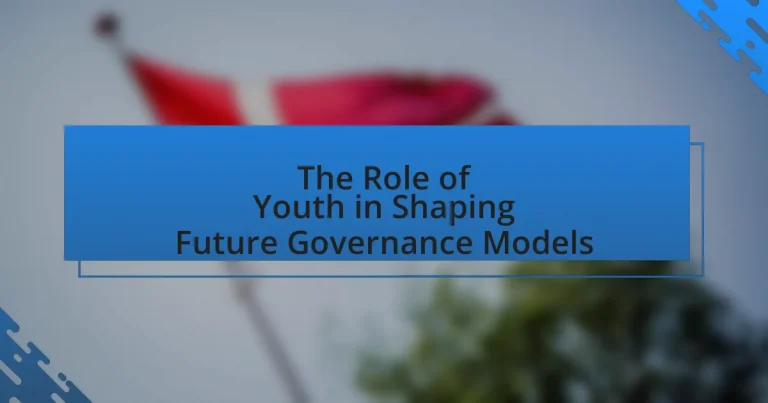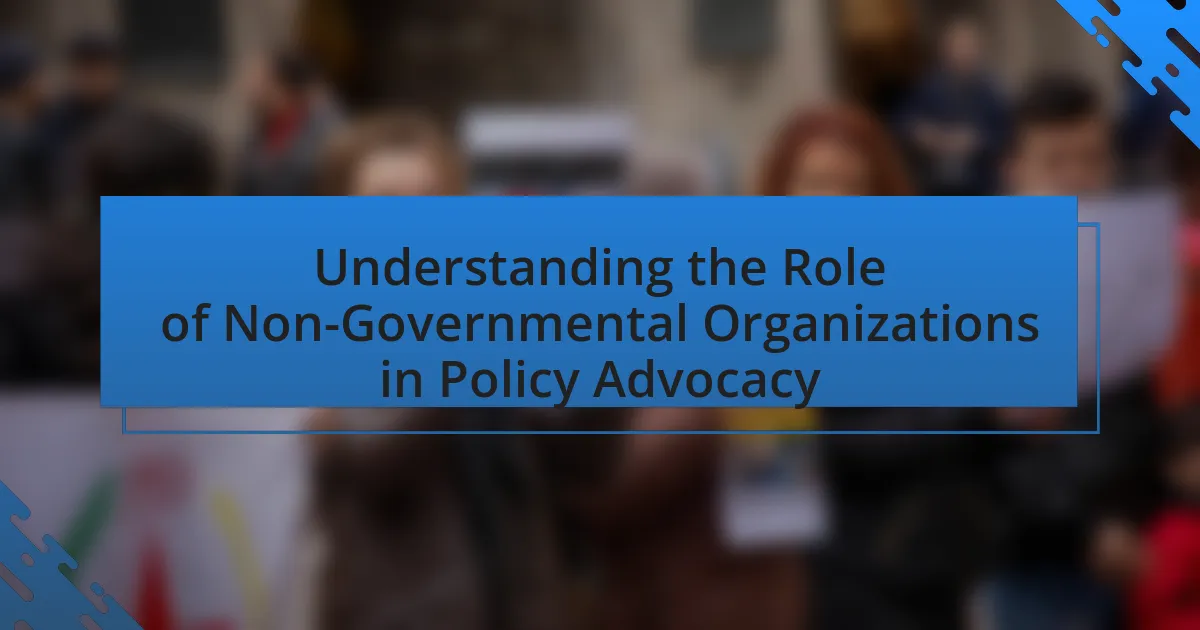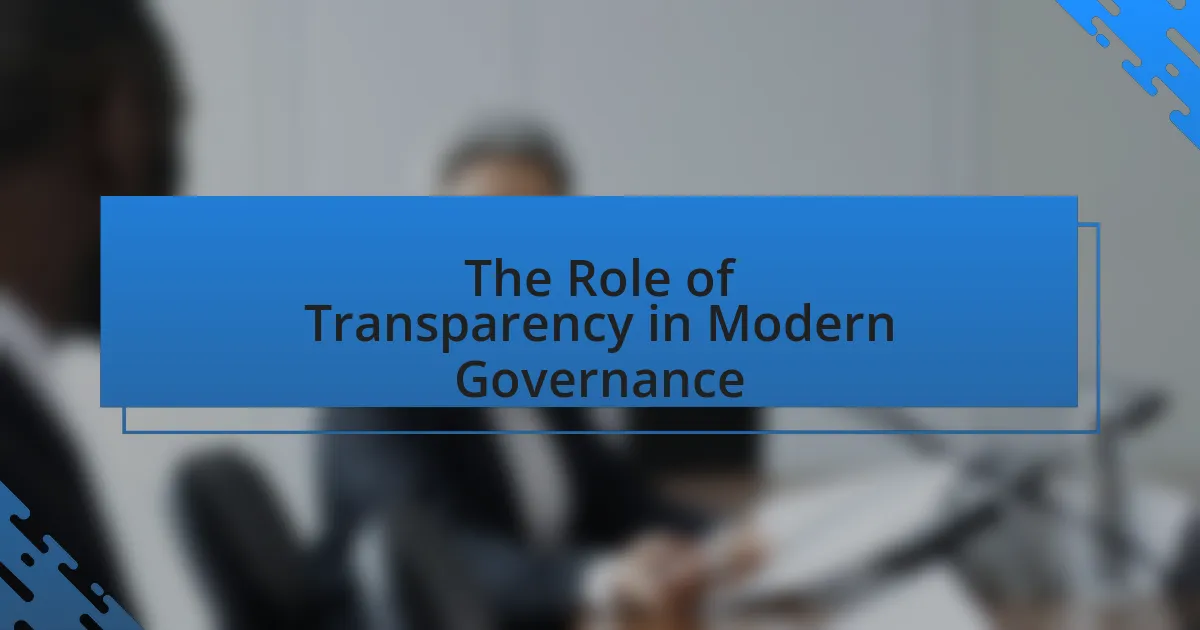The article examines the critical role of youth in shaping future governance models, highlighting their influence on political processes, advocacy for social change, and innovative ideas that challenge traditional governance structures. It discusses how youth perspectives contribute to more inclusive and progressive policies, emphasizing the importance of their engagement in decision-making processes. The article also addresses the challenges youth face in influencing governance, the impact of youth-led movements, and the potential consequences of their exclusion from political discourse. Additionally, it outlines effective strategies for youth advocacy and collaboration with various stakeholders to enhance their influence in governance.
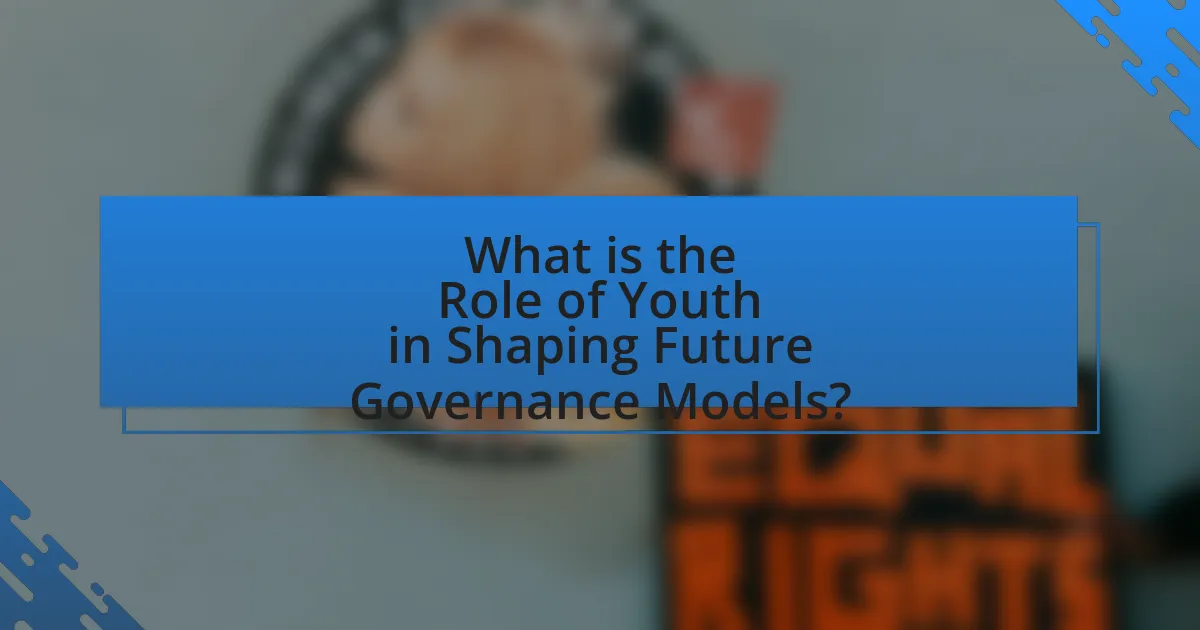
What is the Role of Youth in Shaping Future Governance Models?
Youth play a crucial role in shaping future governance models by driving innovation, advocating for social change, and participating in political processes. Their engagement fosters new ideas and perspectives that challenge traditional governance structures. For instance, youth-led movements, such as the climate strikes initiated by Greta Thunberg, have significantly influenced global policy discussions on climate change, demonstrating the power of youth activism in governance. Additionally, studies show that countries with higher youth participation in governance tend to adopt more progressive policies, reflecting the values and priorities of younger generations. This active involvement not only empowers youth but also ensures that governance models evolve to meet the needs of a changing society.
How do youth perspectives influence governance?
Youth perspectives influence governance by introducing innovative ideas and advocating for issues that resonate with younger generations, such as climate change, social justice, and digital rights. These perspectives often challenge traditional governance structures and push for more inclusive and participatory decision-making processes. For instance, the global youth climate strikes, initiated by activists like Greta Thunberg, have pressured governments to prioritize environmental policies, demonstrating the tangible impact of youth activism on legislative agendas. Additionally, research from the United Nations indicates that engaging youth in governance can lead to more sustainable and equitable policies, as their unique insights reflect the needs and aspirations of a significant demographic.
What unique insights do young people bring to governance discussions?
Young people bring innovative perspectives and a strong understanding of contemporary issues to governance discussions. Their familiarity with technology and social media enables them to engage with diverse communities and advocate for transparency and accountability. For instance, studies show that youth participation in governance can lead to more inclusive policies, as they often prioritize climate change, social justice, and digital rights, reflecting the values of their generation. Research by the United Nations indicates that involving youth in decision-making processes can enhance the legitimacy and effectiveness of governance, as they contribute fresh ideas and challenge traditional norms.
How can youth participation reshape traditional governance structures?
Youth participation can reshape traditional governance structures by introducing innovative ideas and perspectives that challenge established norms. Engaging young people in decision-making processes fosters inclusivity and responsiveness, leading to more adaptive governance. For instance, studies show that countries with active youth engagement in politics, such as Sweden and Canada, have seen increased voter turnout and policy reforms that address youth-specific issues, demonstrating the tangible impact of their involvement.
Why is youth engagement crucial for future governance?
Youth engagement is crucial for future governance because it fosters innovative solutions and ensures that the perspectives of younger generations are represented in decision-making processes. Engaging youth allows for the incorporation of fresh ideas and approaches that can address contemporary challenges, such as climate change and social inequality. According to a 2020 report by the United Nations, youth represent approximately 1.8 billion people globally, making their involvement essential for sustainable development and democratic governance. Furthermore, studies show that when young people participate in governance, they are more likely to develop civic skills and a sense of responsibility, leading to increased political participation in the long term.
What are the potential consequences of excluding youth from governance?
Excluding youth from governance can lead to a lack of representation of their interests and perspectives, resulting in policies that do not address their needs. This exclusion can foster disillusionment and disengagement among young people, diminishing their trust in political systems and institutions. Research indicates that when youth are not involved in decision-making processes, issues such as education, employment, and climate change may be inadequately addressed, as these are often priorities for younger demographics. Furthermore, the absence of youth voices can stifle innovation and adaptability in governance, as younger generations tend to bring fresh ideas and approaches to problem-solving.
How does youth involvement enhance democratic processes?
Youth involvement enhances democratic processes by increasing political engagement and fostering innovative ideas. When young people participate in decision-making, they bring fresh perspectives that can challenge the status quo and address contemporary issues. For instance, studies show that countries with higher youth voter turnout experience more responsive governance, as seen in the 2019 European Parliament elections where youth turnout increased by 20% compared to previous years, leading to a greater focus on climate change and social justice in policy discussions. This active participation not only empowers youth but also strengthens the overall democratic framework by ensuring that diverse voices are heard and represented.
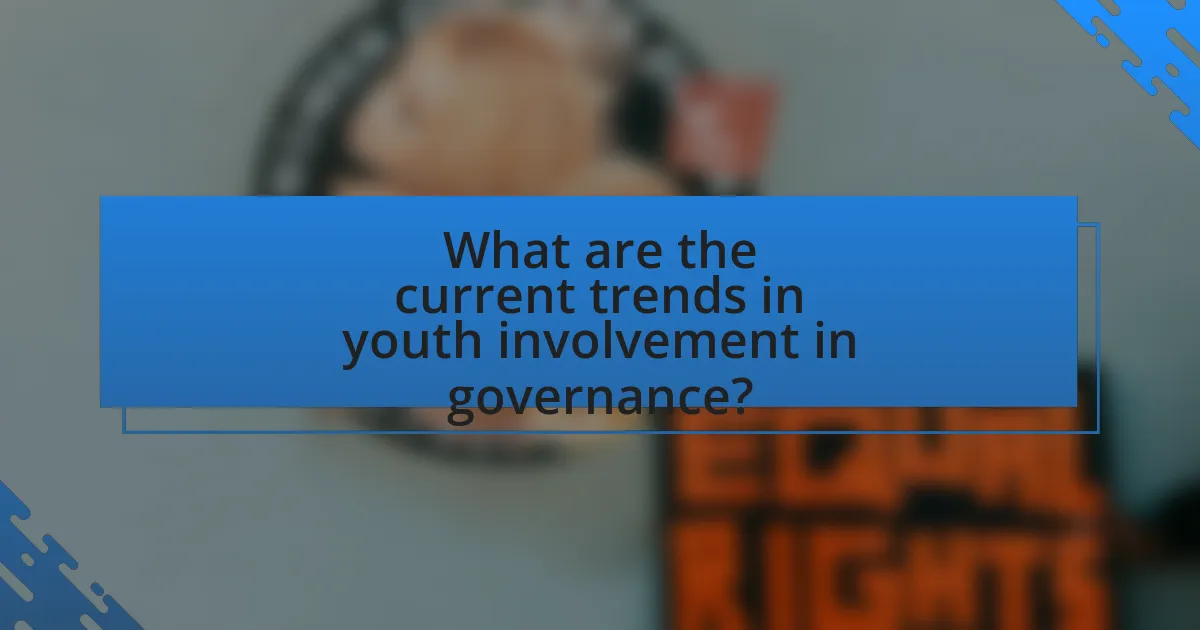
What are the current trends in youth involvement in governance?
Current trends in youth involvement in governance include increased participation in political processes, advocacy for climate action, and the use of digital platforms for engagement. Young people are increasingly mobilizing through social media to influence policy decisions, as seen in movements like Fridays for Future, which emphasizes climate change. Additionally, youth-led organizations are gaining traction in local and national governance, advocating for issues such as education reform and social justice. According to a 2021 report by the United Nations, 70% of young people believe they can influence political decisions, highlighting their growing confidence and agency in governance.
How are young people currently participating in governance?
Young people are currently participating in governance through various channels such as youth councils, social movements, and digital platforms. For instance, many countries have established youth councils that provide a formal mechanism for young individuals to influence policy decisions, allowing them to voice their concerns on issues like climate change and education. Additionally, social movements, such as the global climate strikes led by youth activists, demonstrate their ability to mobilize and advocate for change on a large scale. Furthermore, digital platforms enable young people to engage in political discourse, organize campaigns, and participate in online voting initiatives, thereby enhancing their involvement in governance processes. These forms of participation highlight the increasing recognition of youth as vital stakeholders in shaping governance and policy-making.
What platforms are available for youth to engage in governance?
Youth can engage in governance through various platforms such as youth councils, online forums, social media campaigns, and civic engagement programs. Youth councils, often established by local governments, provide a structured way for young people to voice their opinions and influence policy decisions. Online forums and social media campaigns allow youth to discuss governance issues, mobilize support for causes, and advocate for change on a broader scale. Civic engagement programs, including workshops and volunteer opportunities, equip youth with the skills and knowledge necessary to participate effectively in governance processes. These platforms collectively empower youth to contribute to decision-making and shape future governance models.
How do social movements led by youth impact governance models?
Social movements led by youth significantly impact governance models by advocating for progressive policies and demanding accountability from leaders. These movements often leverage social media to mobilize support, raise awareness, and influence public opinion, as seen in the global climate strikes initiated by youth activists like Greta Thunberg, which pressured governments to adopt more stringent environmental policies. Additionally, youth-led movements have historically contributed to shifts in governance, such as the Arab Spring, where young activists played a crucial role in challenging authoritarian regimes and promoting democratic reforms. This demonstrates that youth movements can reshape governance by introducing new ideas, fostering civic engagement, and holding authorities accountable.
What challenges do youth face in influencing governance?
Youth face several challenges in influencing governance, primarily including lack of access to decision-making processes, limited political representation, and societal apathy towards their contributions. These barriers hinder their ability to effectively advocate for change. For instance, a report by the United Nations indicates that youth make up 1.8 billion of the global population, yet they are often underrepresented in political institutions, with only 2% of parliamentarians being under 30 years old. Additionally, many young individuals encounter systemic obstacles such as age discrimination and a lack of resources, which further complicate their efforts to engage in governance.
What barriers hinder youth participation in governance?
Barriers that hinder youth participation in governance include lack of access to information, limited political engagement opportunities, and societal perceptions that undervalue youth contributions. Research indicates that many young people feel excluded from decision-making processes due to insufficient outreach and communication from governing bodies, which often do not tailor their messages to younger audiences. Additionally, systemic issues such as age discrimination and a lack of mentorship further discourage youth involvement. According to a study by the United Nations, only 27% of young people feel their voices are heard in political discussions, highlighting the significant gap in engagement and representation.
How can these challenges be overcome to enhance youth influence?
To enhance youth influence, challenges can be overcome by implementing targeted educational programs that promote civic engagement and leadership skills. Research indicates that youth who participate in structured civic education are more likely to engage in political processes and advocacy, as evidenced by a study from the Center for Information & Research on Civic Learning and Engagement, which found that students involved in civic education programs showed a 20% increase in voting rates compared to their peers. Additionally, creating platforms for youth voices in decision-making processes, such as youth councils or advisory boards, can empower young individuals and ensure their perspectives are considered in governance. This approach has been successfully adopted in various municipalities, leading to increased youth participation in local governance and policy-making.
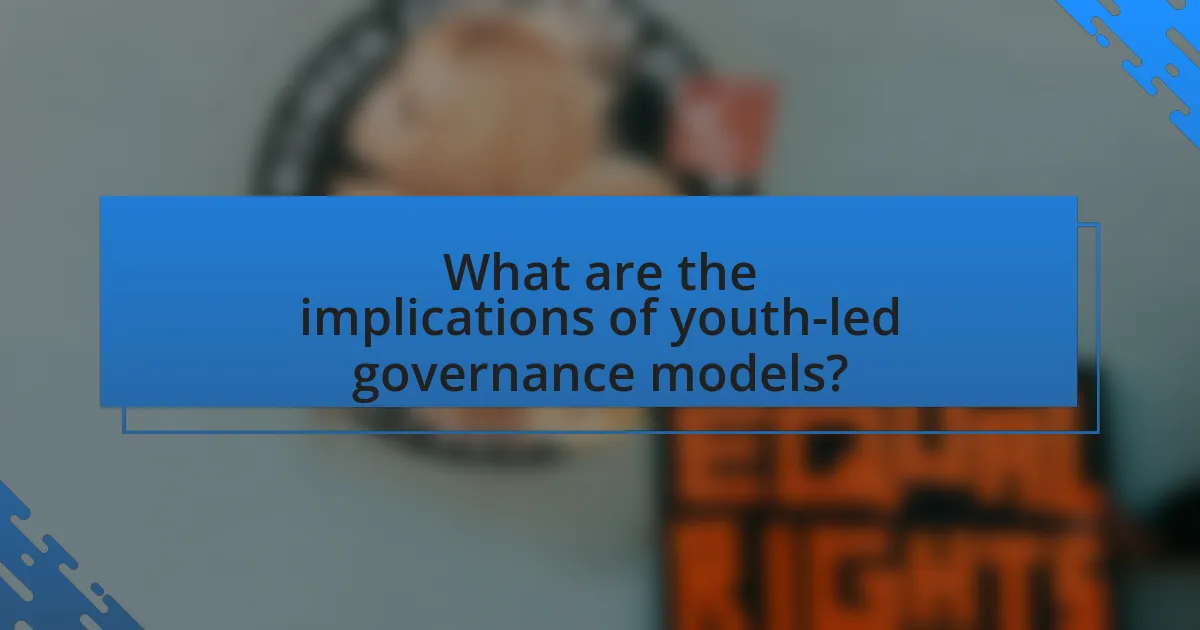
What are the implications of youth-led governance models?
Youth-led governance models empower young individuals to actively participate in decision-making processes, leading to increased representation and responsiveness to the needs of younger populations. These models often result in innovative solutions to social issues, as youth bring fresh perspectives and a strong understanding of contemporary challenges. For instance, research by the United Nations Development Programme highlights that youth engagement in governance can enhance democratic processes and foster social cohesion. Furthermore, youth-led initiatives have been shown to drive policy changes that prioritize sustainability and inclusivity, as evidenced by the success of youth climate movements globally, which have influenced national and international environmental policies.
How do youth-led initiatives differ from traditional governance models?
Youth-led initiatives differ from traditional governance models primarily in their approach to decision-making and inclusivity. While traditional governance often relies on hierarchical structures and established authority figures, youth-led initiatives emphasize participatory methods, empowering young people to take active roles in shaping policies and programs. This shift is evidenced by the rise of organizations like the United Nations Youth Envoy, which promotes youth engagement in global decision-making processes, highlighting that youth representation can lead to more innovative and relevant solutions to contemporary issues. Additionally, youth-led initiatives often prioritize social justice and sustainability, reflecting the values and concerns of younger generations, which contrasts with the sometimes rigid frameworks of traditional governance that may not adapt as swiftly to emerging societal needs.
What innovative approaches are being introduced by youth in governance?
Youth are introducing innovative approaches in governance through digital activism, participatory budgeting, and social entrepreneurship. Digital activism leverages social media platforms to mobilize communities and advocate for policy changes, exemplified by movements like Fridays for Future, which has engaged millions in climate action. Participatory budgeting allows young people to directly influence budget allocations in their communities, fostering transparency and accountability; cities like Paris have implemented this approach successfully. Additionally, social entrepreneurship initiatives led by youth are addressing social issues while promoting sustainable development, as seen in organizations like Ashoka, which supports young changemakers globally. These approaches demonstrate the active role of youth in shaping governance to be more inclusive and responsive to contemporary challenges.
How do these approaches address contemporary governance issues?
These approaches address contemporary governance issues by actively involving youth in decision-making processes, thereby enhancing democratic participation and representation. Engaging young people fosters innovative solutions to pressing challenges such as climate change, social inequality, and digital governance. For instance, initiatives like the United Nations Youth Strategy emphasize the importance of youth voices in policy formulation, which has been shown to lead to more inclusive and effective governance outcomes. Research indicates that countries with higher youth engagement in governance report improved public trust and accountability, demonstrating the positive impact of these approaches on contemporary governance issues.
What lessons can be learned from successful youth-led governance examples?
Successful youth-led governance examples demonstrate the importance of inclusivity, innovation, and community engagement. These examples show that when young people are empowered to lead, they can effectively address issues relevant to their communities, as seen in initiatives like the Youth Climate Strike, which mobilized millions globally to advocate for climate action. Furthermore, research indicates that youth-led organizations often utilize technology to enhance participation and transparency, leading to more informed decision-making processes. For instance, the use of social media platforms in youth activism has proven to amplify voices and foster collaboration, as evidenced by the #BlackLivesMatter movement, which has significantly influenced public discourse and policy changes. These lessons highlight that youth involvement in governance not only brings fresh perspectives but also drives meaningful change through collective action and innovative solutions.
Which case studies highlight effective youth engagement in governance?
Case studies that highlight effective youth engagement in governance include the “Youth Participatory Budgeting” initiative in Porto Alegre, Brazil, and the “Youth Council” model in the United Kingdom. The Porto Alegre initiative, established in 1989, allows citizens, including youth, to participate directly in budget decisions, resulting in increased civic engagement and improved public services. The UK Youth Council, formed in 2000, empowers young people to influence policy decisions at local and national levels, demonstrating significant impacts on youth-related policies. These examples illustrate how structured engagement mechanisms can lead to meaningful youth participation in governance.
What best practices can be derived from these examples?
Best practices derived from examples of youth involvement in governance include fostering inclusive participation, leveraging technology for engagement, and promoting education on civic responsibilities. Inclusive participation ensures diverse voices are heard, as seen in initiatives where youth from various backgrounds contribute to policy discussions. Leveraging technology, such as social media platforms, enhances outreach and mobilization, evidenced by campaigns that successfully engaged young voters. Promoting education on civic responsibilities equips youth with the knowledge to actively participate in governance, as demonstrated by programs that teach democratic processes and critical thinking skills. These practices collectively empower youth to influence governance effectively.
How can youth effectively advocate for their role in governance?
Youth can effectively advocate for their role in governance by engaging in organized movements, utilizing social media platforms, and participating in local decision-making processes. Organized movements, such as youth-led protests and campaigns, have historically influenced policy changes, as seen in the global climate strikes initiated by young activists like Greta Thunberg, which mobilized millions and pressured governments to address climate issues. Social media platforms enable youth to amplify their voices, share information, and connect with like-minded individuals, facilitating grassroots movements and awareness campaigns. Additionally, active participation in local governance, such as attending town hall meetings or joining youth councils, allows young people to directly influence decisions that affect their communities, exemplified by initiatives like the Youth Advisory Council in various cities that provide a platform for youth input in policy-making.
What strategies can youth employ to amplify their voices in governance?
Youth can amplify their voices in governance by actively engaging in political processes, utilizing digital platforms for advocacy, and forming coalitions with like-minded individuals. Engaging in political processes includes voting, participating in town hall meetings, and running for office, which allows youth to influence decision-making directly. Utilizing digital platforms, such as social media, enables youth to raise awareness, mobilize support, and communicate their perspectives to a broader audience. Forming coalitions with other youth organizations enhances their collective power, allowing for more significant impact on policy discussions. According to a 2021 report by the United Nations, youth-led movements have been instrumental in driving social change and influencing governance, demonstrating the effectiveness of these strategies in real-world contexts.
How can collaboration with other stakeholders enhance youth advocacy?
Collaboration with other stakeholders enhances youth advocacy by amplifying the voices of young people and increasing the impact of their initiatives. When youth organizations partner with government agencies, non-profits, and private sector entities, they gain access to resources, expertise, and networks that can elevate their advocacy efforts. For instance, a study by the United Nations Development Programme highlights that collaborative approaches in youth advocacy lead to more comprehensive policy changes, as diverse stakeholders bring different perspectives and solutions to the table. This synergy not only strengthens the legitimacy of youth voices but also fosters a more inclusive decision-making process, ultimately resulting in policies that better reflect the needs and aspirations of young people.
